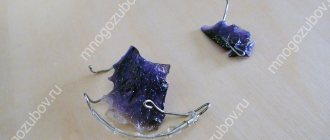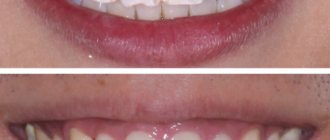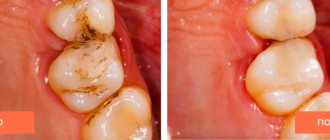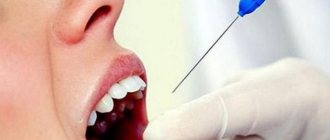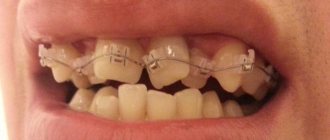An even row of teeth is a sign of beauty and health. Although many people dream of a Hollywood smile only for aesthetic reasons, in fact, a correct bite is very important for the whole body. Therefore, dentists recommend resorting to orthodontic correction immediately after identifying a problem. Protruding teeth can be either a congenital defect or an acquired one. Modern medicine has something to offer in both cases.
Causes of protruding teeth
Most often, the two central teeth protrude forward due to the large grouping and strong pressure of the dentition. Also, the reason may be their initially incorrect position. But it is possible that there is a malocclusion after correction. Many people who wear braces experience a similar problem: protruding front teeth.
There are several causes of the pathology:
- 1. Premature cessation of treatment. External improvements do not always mean full recovery. When braces are removed prematurely, the central teeth gradually move forward.
- 2. Failure to comply with doctor's recommendations. Unauthorized cessation of alignment naturally leads to the return of bone tissue to its original place.
- 3. Incorrect installation of braces. It is possible that the arc tension is insufficient or certain anatomical features of the patient are ignored.
- 4. Rare visits to the supervising orthodontist. Throughout the entire correction period, it is important to make changes and also monitor the design of the braces, which can break without a person noticing.
5. The most common reason for protruding front teeth is ignoring the retention period. After the braces are removed, the treatment does not end, but continues. Every competent doctor knows how important it is to consolidate the result. A frivolous attitude and refusal to further consult an orthodontist will inevitably lead to the return of previous defects.
Rotation
Twisting of teeth around a vertical axis often occurs in children who, during teething, suffer from bad habits: licking or biting their lips, sticking out the tip of their tongue. Teeth that have just erupted are pliable and easily take on the wrong position. Rotation also occurs due to lack of space, so it is more likely to affect those who have naturally large teeth. Therefore, during rotation, jaw expansion is also necessary.
Rotated teeth
Methods for eliminating the defect
Direct veneers or crowns can be used to correct protruding teeth. But this method is more of an aesthetic nature. It does not solve the problem at the root, but only masks it. Veneers are suitable if one or maximum two teeth are protruding.
To correct the bite, it is recommended to use braces. The disadvantage of this treatment is the long period. But the advantages are invaluable, because as a result it is possible to correct the location of each individual tooth.
In some cases, several teeth may have to be removed. This is done when there is a lot of crowding and there is no space for straightening the teeth.
If the central teeth protrude after wearing braces, a different treatment system is used.
During the so-called retention period it is recommended to use:
- removable retainers;
- fixed retainers.
Which type to choose depends on the complexity of the curvature. If it is minor, removable mouthguards are used. They are plastic overlays that perfectly fit the shape of your teeth. Mouthguards are made individually, based on an impression. If it is necessary to strengthen the structure, wire is installed in the retainers. The orthodontist develops a plan for wearing mouth guards.
Fixed retainers are metal arches. They are attached to problem areas and cannot be removed. Fixation occurs on the inside of the teeth, so the patient does not feel discomfort when wearing them. The duration of use of the arches, as well as their shape, is selected individually.
Unfortunately, the problem of protruding teeth cannot always be solved with veneers or braces. If long-term correction does not give the desired result, the doctor may recommend using the Herbst apparatus. The non-removable design corrects even very complex defects in just 1 year. Changes are visible immediately after its fixation. The Herbst appliance gradually moves the upper jaw backward and the lower jaw forward.
Protrusion/retrusion (tilting)
Protrusion is the tilting of teeth forward. Retrusion is a backward deviation. Both can be a separate aesthetic defect or combined with occlusion pathology. This is due to the fact that the upper teeth lose contact with the lower teeth when they deviate from the correct position. But the teeth always tend to close together, so the bottom row can also begin to move to get closer to the top.
Protrusion of the upper teeth
Therefore, there are practically no violations in only one jaw. If something moves on one of them, it immediately pulls the other along with it.
The peculiarity of protrusion is that if it is strongly expressed, it is reflected not only in the smile, but also on the face as a whole. Due to protruding teeth, the upper lip may rise and the mouth will always be slightly open.
Consequences of malocclusion
If the defect does not create physical inconvenience, then you can ignore it. This is a misconception held by many people who experience protruding front teeth. In fact, this is not only an aesthetic flaw.
Incorrect bite leads to very disastrous consequences, various kinds of complications affecting all organs and systems.
Here are some of them:
- 1. Accelerated tooth decay. Uneven chewing load leads to grinding of incisors, formation and development of caries.
- 2. Deformation of the facial part of the skull. An aesthetic defect that affects the beauty of a smile, the appearance of the profile.
- 3. Disruption of the gastrointestinal tract. With an incorrect bite, chewing food is not of sufficient quality, which leads to diseases of the digestive system.
- 4. Development of periodontal disease. Inflamed gums cause physical discomfort. In addition, they can cause tooth loss.
- 5. Impaired functioning of the temporomandibular joint. If the problem is ignored for a long time, neuralgia and arthritis develop.
Protruding front teeth are the tip of the iceberg, underneath which lies a huge number of problems. The consequences of malocclusion worsen over the years. They concern not only the oral cavity, but the whole body. With protruding front teeth, beautiful diction and correct articulation are impossible. In addition, they can make breathing difficult. If the bite is incorrect, prosthetics become more difficult.
Periodontitis by location
There are two main divisions in the classification of periodontitis based on the location of the disease: apical and marginal. The first option (apical) is also apical, based near the apex of the tooth root. This type is the most common, since periodontal infection in most cases occurs through a descending channel: from caries to inflammation of the pulp, and then through the root canal the infection descends into the periodontal tissue. This process most often becomes chronic, since the protective mechanisms of the periodontium are much more powerful than those of the pulp. Therefore, the infection can enter the deep tissues of the tooth for years without causing signs of disease.
Marginal chronic periodontitis is located on the lateral walls of the tooth root and has the etiology of microtraumas.
Periodontitis, the treatment stages of which are a complex, complex process, requires immediate attention to a dental clinic. It is safe to say that such a diagnosis requires highly qualified specialists with extensive experience in solving such problems. Dentists of the LeaderStom network of clinics are rightfully considered the best in this area of dental therapy. The latest technologies, progressive techniques and extensive practice allow them to cope with the most complex, advanced cases.
Preventing protruding teeth
It is easier to prevent any problem than to treat it. Therefore, at the first signs of dental deformation, it is recommended to consult a doctor.
To achieve a positive result you must:
- 1. Correctly use braces, veneers, Herbst apparatus and other modifications of orthodontic devices. Do not remove them ahead of time and if you suspect a violation or breakdown, immediately contact a specialist.
- 2. Listen to your doctor's advice. The orthodontist sees the big picture, so he or she will know better which treatments to use and for how long. It is important to attend all appointments to ensure timely adjustments to the devices and monitor changes.
- 3. Provide a psychologically healthy climate. Stressful situations, poor sleep, excessive physical and mental stress negatively affect all organs and systems, including bone tissue that needs to be corrected.
- 4. Eat right. A balanced diet and the intake of vitamins and minerals have a positive effect on regeneration processes in bone tissue and help eliminate malocclusions.
Beautiful teeth are not always a gift from nature. Most often, the painstaking work of an orthodontist is hidden behind a Hollywood smile. It is necessary to understand that the older the patient, the more advanced the problem, the longer it will take to correct the defect. After 25 years, processes in bone tissue slow down. Therefore, if there is such an opportunity, you need to start treatment in childhood or adolescence.
Also, we must not forget about the retention period. It lasts no less than the period of wearing braces. Consolidation of the result is necessary, because otherwise the ligaments will return the teeth to their original place. Thanks to the methods of modern medicine, the process of teeth straightening occurs relatively quickly and painlessly.
Types and differential diagnosis
Like most diseases, periodontitis can occur in acute or chronic form. Sluggish periodontal inflammation is divided into three types:
Granulating
Depending on the type of infection that affects the tooth tissue, and on the specific immune response of the body, various kinds of altered tissues are formed in the periodontal cavity. With chronic periodontitis of this type, granulating tissue appears. It looks like a loose red formation near the top of the tooth root, which quickly grows and thereby destroys the bone tissue of the jaw. Of all three types of chronic inflammation, granulating periodontitis is considered the most active and pronounced. Its characteristic manifestation is the formation of fistulas, which can keep the tooth in a latent form of the disease for a long time. Connective tissue can not only affect the plate of the alveolar process (jaw), but also spread even to the skin. Therefore, advanced cases of periodontitis are much more difficult to treat and can affect large areas of tissue, including adjacent teeth. An X-ray image allows differentiation of granulating periodontitis from other types of periodontal disease. It clearly shows darkening in the area of the apex of the tooth root with circular outlines of tissue or in the form of flames. At the same time, the image does not show sharp boundaries, as in some other classifications of periodontitis. These dark spots indicate that the bone tissue has dissolved as a result of inflammation and has been replaced by connective tissue.
Fibrous
This form of the disease is quite rare and is accompanied by an asymptomatic chronic course. As a result of sluggish periodontitis, connective fibrous tissue forms around the tooth root. It is denser and is visible on an x-ray as a periodontal tooth gap, more widened than usual. The result of the appearance of fibrous tissue can be:
- suffering from acute periodontitis, which was successfully treated;
- poor-quality filling of tooth root canals;
- lack of treatment for granulating periodontal inflammation.
If the disease has entered the stage of remission (quiescence), and the patient does not complain about the causative tooth, then fibrous periodontitis cannot be treated. However, in cases of exacerbation, therapy in the form of refilling the root canals of the tooth is possible.
Granulomatous
If granulating periodontitis does not have clear outlines on an x-ray, then granulomatous periodontitis is characterized by the presence of a capsule with purulent contents. It occurs at the apex of the tooth root and gradually grows, affecting the bone tissue.
There are three degrees of development of periodontal abscess:
- Granuloma. The size of the capsule with this diagnosis reaches 0.5 cm in diameter.
- Cystogranuloma. It is diagnosed when the dense membrane reaches 1 cm.
- Cyst. More than one centimeter in diameter suggests the cystic development of periodontitis.
An increase in granuloma indicates that the inflammatory process does not find a way out and continues to dissolve the bone tissue near the tooth. In this case, a whole chain of pathological processes occurs in the human body. Sometimes particularly advanced cases showed a cyst of up to 4-5 cm in the tissue, which significantly impaired the integrity of the lower jaw, increasing the risk of its fracture.
On the other hand, the accumulation of serous fluid in the tooth area regularly causes additional intoxication to the entire body, which can be accompanied by periods of weakness, fatigue, low-grade fever and other symptoms of periodontitis.
Among all forms of chronic
Granulomatous periodontitis is considered to be the most sluggish. The fibrous tissue of the capsule serves as a protective barrier that prevents pathogenic bacteria from entering the blood. Therefore, the liquid in the capsule can remain in the tooth tissue for years without showing itself. Depending on their location, granulomas can be located either immediately under the root apex or in the tissues of the lateral cavity.
Classification
With pathology, the upper teeth protrude forward, completely or partially covering the lower row. In this position, the jaws can no longer close together normally. In rare cases, an abnormal location is observed not in the front, but in the lateral teeth of the upper jaw.
There are 2 types of pathology:
- Neutral bite. This anomaly cannot always be determined by external examination of the oral cavity. Even in an adult whose bone tissue is fully formed, the pathology may not manifest characteristic signs. In the case of a neutral occlusion, the chin does not change its natural structure, and serious facial disproportions are not noticeable. The main signs of the pathological condition are the overlap of the lower jaw with the teeth of the upper row, the presence of a noticeable supramental fold.
- Distal bite. In such a situation, the symptoms of pathology are clearly expressed. In adults, there is disproportion of the face, with the chin being unnaturally small and slightly moved back.
The diagnosis of malocclusion is made definitively after examination by a dentist.
How to correct an overbite
To correct malocclusion at an early age, more gentle methods are used. An effective method of combating abnormal bite is gymnastics for the facial muscles. Such exercises in medicine are called myogymnastics. The results of the procedure can only be achieved with regular exercise.
Bite trainers
In order to correct bites in children and even simple dental defects in adults, it is not at all necessary to install complex, inconvenient and expensive devices.
The following types of gymnastic techniques are common:
- Bringing the lower jaw forward. Remain in this position for several minutes, and then relax the facial muscles. Gymnastics are performed until a feeling of fatigue appears in the jaw muscles.
- Raising the tongue. During the exercise, the tongue extends and rises to the area of the upper palate.
Correction of abnormal bite in children
Maximum results can be achieved by combining myogymnastics and orthodontic devices. To correct the bite on baby teeth, devices with screws are used that regulate the width of the structure and the development of bone structures.
In some cases, trainers or LD activators are prescribed to correct the defect. The main purpose of using structures is to give the lower jaw a natural position and relax the facial muscles.
Orthodontic appliances are effective for both primary and molar teeth. Removable dentures can be used before installing braces, while the use of trainers reduces the time of wearing the regulatory system. It is important to remember that you can achieve results from wearing removable correctors only with their regular use.
In children from 8 years of age, Twin Block systems can be used to correct the bite. The device consists of two plates that act on bone tissue mechanically. In this case, the lower jaw moves forward. Before installing the system, I take an impression of the teeth and determine the type of anomaly.
In some cases, patients are offered the installation of partial braces on already renewed teeth. The design allows you to align abnormally located elements and give them the correct angle.
In advanced cases of problems or when the above methods do not produce results, the Herbst device is used. It consists of two spring elements, one of which is attached to the upper jaw (sixes), and the other to the lower row of teeth (premolars). The mechanism gradually aligns the position of the jaw system, pushing the lower row of teeth forward and the upper row back.

